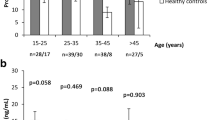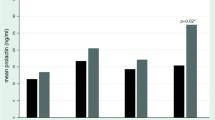Abstract
The effects of single and repeated electroconvulsive treatment (ECT) on β-endorphin (β-EP), cortisol, growth hormone (GH) and prolactin (Prl) plasma levels were investigated in nine depressed patients. Blood samples were monitored a day before ECT, the day of the first and sixth ECT (0, 30, 60 and 90 min after seizures), the day afterwards and 4 weeks after termination of the ECT course.
A significant elevation of β-EP levels was achieved immediately with and 24 h after the first and the sixth ECT. A transient increase in basal β-EP was observed 1 day following the sixth ECT in comparison with pre-treatment level. Peak and 30 min levels of cortisol were increased compared with baseline by the first ECT. The former (peak) but not the latter (30 min) were increased also at the sixth treatment. GH levels were decreased the day after the first ECT in comparison with the pre-treatment levels and immediately following each ECT in comparison with baseline. A trend toward elevation of Prl was observed immediately after the first and sixth ECT, although the rise did not reach significant levels. ECT administration stimulated β-EP and cortisol secretion and suppressed human GH release, possibly by activation of endorphinergic and/or serotonergic systems. These mechanisms might be involved in the beneficial effect of ECT in depression.
Similar content being viewed by others
References
Alexopoulos GS, Inturrissi CE, Lipman R, Frances R, Haycox J, Dougherty JH, Rossier J (1983) Plasma immunoreactive β-endorphin levels in depression. Arch Gen Psychiatry 40:181–183
American Psychiatric Association (1980) Diagnostic and statistical manual of mental disorders (3rd ed). Washington, DC
Aperia B, Thoren M, Zettergren M, Wettenberg L (1984) Plasma pattern of adrenocorticotropin and cortisol during electroconvulsive therapy in patients with major depressive illness. Acta Psychiatr Scand 70:361–369
Arato M, Bagdy G (1982) Neuroendocrine study of the mechanism of action of electroconvulsive therapy. Neuropsychobiology 8:162–168
Balldin J (1982) Factors influencing prolactin release induced by electroconvulsive therapy. Acta Psychiatr Scand 65:365–369
Beck AT, Beamesderfer A (1974) Assessment of depression: The depression inventory. Mod Probl Pharmacopsychiatry 7:151–169
Belenky GL, Holaday JW (1979) The opiate antagonist naloxone modifies the effects of electroconvulsive shock (ECS) on respiration, blood pressure and heart rate. Brain Res 177:414–417
Belenky GL, Holaday JW (1980) Electroconvulsive shock (ECS) in rats: Naloxone modification of post-ECS behaviors provides evidence for functional endorphin release. In: Way EL (ed) Endogenous and exogenous opiate agonists and antagonists, Pergamon, New York, pp 487–490
Bruni JF, Hawkins RL, Yen SSC (1982) Serotonergic mechanism in the control of β-endorphin and ACTH release in male rats. Life Sci 30:1247–1254
Clement-Jones V, Besser GM (1983) Clinical perspectives in opioid peptides. Br Med Bull 39:95–100
Deakin JFW, Ferrier IN, Crow TJ, Johnston EC, Lawler P (1983) Effects of ECT on pituitary hormone release: Relationship to seizure, clinical variable and outcome. Br J Psychiatry 143:618–624
d'Elia G, Raotma H (1975) Is unilateral ECT less effective than bilateral ECT. Br J Psychiatry 126:83–89
deMontigny C (1984) Electroconvulsive shock treatments enhance responsiveness of forebrain neurons to serotonin. J Pharmacol Exp Ther 228:230–234
Emrich HM, Holt V, Kissling W, Fischler M, Heineman H, von Zersson D, Herz A (1979) Measurement of β-endorphin-like immunoreactivity in CSF and plasma of neuropsychiatric patients. Adv Exp Med Biol 116:307–317
Grahame-Smith DG, Green AR, Costain DW (1978) Mechanism of the antidepressant action of electroconvulsive therapy. Lancet I:245–256
Guillemin R, Vargo T, Rossier J, Minick S, Ling N, Rivier C, Vale W, Bloom F (1977) β-Endorphin and adrenocorticotropin are secreted concomitantly by the pituitary gland. Science 197:1367–1369
Haskett RF, Zis AP, Albala AA (1985) Hormone response to repeated electroconvulsive therapy: effects of naloxone. Biol Psychiatry 20:623–633
Hong JS, Gillin JC, Yang HYT, Costa E (1979) Repeated electroconvulsive shocks and the brain content of endorphins. Brain Res 177:273–278
Janowsky D, Judd L, Huly L, Roitman N, Parker D, Segal D (1978) Naloxone effects on manic symptoms and growth hormone levels. Lancet II:320
Katz RJ, Schmaltz K (1980) Reduction in opiate activation after chronic electroconvulsive shock: Possible role for endorphins in the behavioral effects of convulsive shock treatment. Neurosci Lett 19:85–88
Kendell RE (1981) The present status of electroconvulsive therapy. Br J Psychiatry 139:265–283
Kline NS, Li CH, Lehmann HE, Lajtha A, Laski E, Cooper T (1979) β-Endorphin-induced changes in schizophrenic and depressed patients. Arch Gen Psychiatry 34:1111–1113
Lal S, Tolis G, Martin JB, Brown GM, Guyda H (1975) Effect of clonidine on growth hormone, prolactin, luteinizing hormone, follicle-stimulating hormone and thyroid-stimulating hormone in the serum of normal man. J Clin Endocrinol Metab 41:827–832
Lewis DA, Sherman BM (1984) Serotonergic stimulation of adrenocorticotropin secretion in man. J Clin Endocrinol Metab 58:458–462
Lindstrom LH, Widerlov LM, Gunne L, Wahlstrom A, Terenius L (1978) Endorphins in cerebrospinal fluid: Clinical correlations of some psychotic states. Acta Psychiatr Scand 57:153–164
Linnoila M, Litovitz G, Scheinin M, Chang MD, Culter NR (1984) Effects of electroconvulsive treatment on monoamine metabolites, growth hormone and prolactin in plasma. Biol Psychiatry 19:79–84
Mandel MR (1975) Electroconvulsive therapy for chronic pain associated with depression. Am J Psychiatry 132:632–636
Meyer JS, McElroy JF, Yehuda R, Miller J (1984) Serotonergic stimulation of pituitary adrenocortical activity in rats: Evidence for multiple sites of action. Life Sci 34:1891–1898
Misiaszek J, Cork RC, Hameroff SR, Finley J, Weiss JL (1984) The effect of electroconvulsive therapy on plasma β-endorphin. Biol Psychiatry 19:451–455
O'Dea JPK, Gould D, Hallberg M, Wieland R (1978) Prolactin changes during electroconvulsive therapy. Am J Psychiatry 135:609–611
Pilc A, Vetulani J (1982) Depression by chronic electroconvulsive treatment of clonidine hypothermia and [3H]clonidine binding to rat cortical membranes. Eur J Pharmacol 80:109–113
Prange-Hansen D (1971) The effect of adrenergic receptor blockade on the exercise-induced serum growth hormone rise in normals and juvenile diabetics. J Clin Endocrinol Metab 33:807–812
Risch SC (1982) β-Endorphin hypersecretion in depression: Possible cholinergic mechanisms. Biol Psychiatry 17:1071–1079
Siever LJ, Murphy DL, Slater S, de la Vega E, Lipper S (1984) Plasma prolactin changes following fenfluramine in depressed patients compared to controls: An evaluation of central serotonergic responsivity in depression. Life Sci 34:1029–1039
Skrabanek A, Balfe A, Webb M, Maguire J, Powell D (1981) Electroconvulsive therapy (ECT) increases plasma growth hormone, prolactin, luteinizing hormone and follicle-stimulating hormone but not thyrotropin or substance P. Psychoneuroendocrinology 6:261–267
Swartz C, Abrams R (1984) Prolactin levels after bilateral and unilateral ECT. Br J Psychiatry 44:643–645
Vetulani J, Lebrecht V, Pilc A (1981) Enhancement of responsiveness to the central serotonergic system and serotonin-2 receptor density in rat frontal cortex by electroconvulsive treatment. Eur J Pharmacol 76:81–85
Weiner RI, Ganong WF (1978) Role of brain monoamines and histamine in regulation of anterior pituitary secretion. Physiol Rev 58:905–976
Whalley LJ, Dick H, Watts AG, Christie JE, Rosie R, Levy G, Sheward WJ, Fink G (1982) Immediate increases in plasma prolactin and neurophysin but not other hormones after electroconvulsive therapy. Lancet II:1064–1068
Zis AP, Haskett RF, Albala A, Carroll BJ, Lohr NE (1985) Opioid regulation of hypothalamic-pituitary-adrenal function in depression. Arch Gen Psychiatry 42:383–386
Author information
Authors and Affiliations
Rights and permissions
About this article
Cite this article
Weizman, A., Gil-Ad, I., Grupper, D. et al. The effect of acute and repeated electroconvulsive treatment on plasma β-endorphin, growth hormone, prolactin and cortisol secretion in depressed patients. Psychopharmacology 93, 122–126 (1987). https://doi.org/10.1007/BF02439598
Received:
Revised:
Issue Date:
DOI: https://doi.org/10.1007/BF02439598




